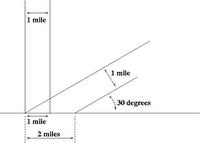
If you've gardened for a while here in the Sunshine State, you quickly learn to be leery of the advice to plant anything "in full sun." Every newbie who's planted a geranium in June in full sun, because that's what he did in Jersey, learns that full sun is a death sentence for all but but a few plants. Aside from trees and some large shrubs, I'm hard-pressed to think of many plants that actually do better here in Florida in full sun than they do in high shade.
For instance: Even roses, plants famous for their love of sun, are taxed in June and July by noontime's glare. You'll read that roses need at least six hours of full sun and do best with ten, but that's for Yankees. Here in Florida, roses will thrive with just four or five hours of direct sun, especially if they continue to get some additional time of bright light. My main rose bed, where 'Prosperity', 'Don Juan' and 'Abraham Darby' compete for place of honor, gets about six hours of sun in June, and some bright light in the late afternoon. This amount seems pretty optimal. I have other roses, interplanted with herbaceous perennials, in a border that get ten hours of sun: They need additional water, and don't seem to do any better than their less-sunny comrades.
I could provide plenty more examples of plants famous for their love of full sun elsewhere that quite prefer a little shade here in Florida. So why is this? Why does "full sun" elsewhere, farther northward, so often mean "partial sun" here? Of course the answer is: The sun is just stronger here in FLA. But that's like responding to the question: Why does the train move? with the answer: Because the wheels turn.
Why is the sun stronger?
DeLand, where I live, is located at 29° of latitude, which makes it about two-thousand miles from here to the equator. (Each degree of latitude is approximately 70 miles. Traveling northward, two-thousand miles is roughly the distance between here and the Hudson Bay in Ontario. So, Central Florida is midway between the Hudson Bay and Columbia.) That relative proximity to the equator has a profound, positive relationship to the amount of insolation—the amount of radiant solar energy—any given point of earth receives.
Of course, everyone knows that the equator is where the sun is strongest, where the day is more or less the same length all year long, and where there are no seasons. But returning to our earlier question: Why is the sun stronger at the equator? Largely, this difference is due to the axial tilt (23°) of the earth. The sun's rays hit the earth at a higher angle—more perpendicularly— at the equator than anywhere else on the planet. Twice a year (the autumnal and vernal equinoxes), the equator is directly perpendicular to the rays of the Sun: At noon on the equinoxes, the sun is directly overhead and the rays of the sun hit the earth perpendicularly. On those dates, at every point along the equator, the earth receives its greatest amount of radiant energy.
So, here's the rule: The closer one is to the equator, the more vertically the Sun's rays fall on the earth. The amount of radiant energy is directly correlated with the degree to perpendicular that the Sun's rays hit the earth: The closer to perpendicular, the great the radial energy. This correlation has to do with both simple geometry, and with atmospheric effects: When the s
 un is at a lower angle (closer to the horizon), as it is the farther north one goes, a given point on the earth's surface receives a lower density of incident light. This difference in density of incident light is, fundamentally, similar to the difference in intensity between, say, early morning light an noontime sun. The higher the sun in the sky, the more intense the solar radiation, and the more solar energy made available to photosynthesis for conversion into sugar. Furthermore, the lower the Sun's angle relative to the earth, the more of the earth's atmosphere that the sun has to pass through.
un is at a lower angle (closer to the horizon), as it is the farther north one goes, a given point on the earth's surface receives a lower density of incident light. This difference in density of incident light is, fundamentally, similar to the difference in intensity between, say, early morning light an noontime sun. The higher the sun in the sky, the more intense the solar radiation, and the more solar energy made available to photosynthesis for conversion into sugar. Furthermore, the lower the Sun's angle relative to the earth, the more of the earth's atmosphere that the sun has to pass through.So, what's this all mean to the Central Florida gardener? The map to the right gives a rough idea of the difference in insolation: If you click it and look carefully, you'll notice that Central Florida receives, annually per day, about 25% more insolation, more kilowatts per meter per day, than, say, Boston.
No comments:
Post a Comment